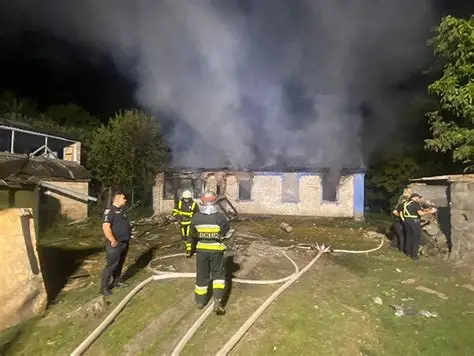In a dramatic escalation of tensions between NATO and Russia, Poland confirmed that it intercepted and shot down several Russian drones after what officials described as an “unprecedented airspace violation.” The incident, which occurred overnight near Poland’s eastern border with Ukraine, has sent shockwaves through Europe and reignited fears of a broader regional conflict.
As Europe’s frontline state in the Ukraine war, Poland has repeatedly warned of Russia’s willingness to test NATO’s resolve. This latest episode, however, marks a turning point: it is one of the first times Warsaw has openly engaged in defensive military action against Russian assets directly.
This article examines the details of the incident, Poland’s response, the NATO dimension, Moscow’s reaction, and the broader implications for European and global security.
The Incident: What Happened in Polish Airspace
According to Poland’s Ministry of Defense, multiple Russian drones crossed into Polish airspace during an overnight barrage targeting Ukraine.
Location: The incursion reportedly took place near the Lublin region, not far from the Ukrainian border.
Nature of the Threat: The drones were believed to be part of Russia’s large-scale attack on Ukrainian infrastructure, some of which deviated off course and penetrated NATO airspace.
Poland’s Response: Polish air defense systems were immediately activated. Fighter jets were scrambled, and several drones were successfully intercepted and destroyed before they could travel further into the country.
Damage Assessment: Early reports suggest minimal damage on Polish soil, though debris from intercepted drones fell in rural areas. No casualties have been reported.
Polish officials described the event as “the most serious breach of our sovereign airspace since the beginning of Russia’s war in Ukraine.”
Why This Violation Is “Unprecedented”
Airspace violations by Russian drones have occurred before, but Poland’s government insists this incident is different:
Scale: The number of drones involved was significantly higher than in past incursions.
Depth: At least one drone reportedly traveled more than 20 kilometers inside Polish territory before being neutralized.
Intent: While Moscow claims the breach was accidental, Warsaw believes the scale suggests deliberate testing of NATO’s response capabilities.
Timing: The violation occurred during one of Russia’s largest missile and drone assaults on Ukraine in weeks, amplifying the threat perception.
The word “unprecedented” is being used in Warsaw not just as a descriptor but as a warning to NATO allies that Poland may soon be forced into more active defense measures.
Poland’s Firm Response
Poland’s leaders were quick to frame the event as an assault on national sovereignty and a test of NATO’s collective defense commitments.
Prime Minister’s Statement: “Poland will not hesitate to defend every inch of its territory. This was a deliberate violation, and we demand accountability,” Prime Minister Donald Tusk declared in an emergency press conference.
Military Readiness: Poland announced that additional air defense batteries are being moved to border regions.
Diplomatic Pressure: Warsaw has summoned Russia’s ambassador, accusing Moscow of reckless aggression and warning of consequences.
For Poland, the incident is more than a military matter—it is a political message to NATO that the country stands as the alliance’s shield on the eastern flank.
NATO’s Reaction
As expected, NATO quickly backed Poland.
Any deliberate attack on NATO territory will be met with a unified and decisive response.”
Consultations Underway: Article 4 of the NATO treaty, which allows members to consult when their security is threatened, may be invoked. While this falls short of the Article 5 mutual defense clause, it signals heightened seriousness.
Allied Reinforcements: U.S. and British officials have already offered additional support in terms of air defense systems and intelligence sharing.
NATO is careful not to escalate into direct confrontation with Russia but cannot appear weak in defending its borders.
Moscow’s Response: Accident or Provocation?
Russia, predictably, has denied deliberate intent.
Official Line: The Kremlin insists the drones that entered Poland’s airspace “strayed off course” due to technical malfunctions.
Blame Game: Moscow accuses Warsaw of “hysterical overreaction” and claims NATO is using the incident as a pretext to escalate involvement in the Ukraine conflict.
Propaganda Spin: Russian state media portrays the shoot-down as proof that Poland is seeking excuses to drag NATO deeper into the war.
Despite these denials, few in Warsaw or Brussels believe the explanation. Many analysts argue that Russia is deliberately probing NATO defenses to gauge response times and willingness to act.
Historical Context: Poland as NATO’s Frontline
Poland’s geographic position has long made it a buffer state between Russia and Western Europe.
Hosted millions of Ukrainian refugees.
Supplied weapons and logistical support to Kyiv, often acting as a transit hub for Western aid.
Increased defense spending to over 4% of GDP—among the highest in NATO.
Stationed U.S.
Given this backdrop, the drone incursion strikes a nerve. For Poles, memories of Soviet domination remain fresh, and the war in Ukraine is seen as a fight for the survival of Europe’s eastern democracies.
Risk of Escalation
The key question is whether this incident pushes NATO and Russia closer to direct confrontation.
Poland’s Resolve: Warsaw has hinted it may intercept drones even before they cross its border if they pose a threat—raising the risk of confrontation inside Ukrainian airspace.
Russian Calculations: If Moscow intended the breach as a test, it may escalate further, deploying more drones or even manned aircraft near NATO borders.
Accidental Clashes: With so many military assets in close proximity, the risk of unintended escalation grows.
Analysts warn that while both NATO and Russia may want to avoid a direct clash, miscalculations are increasingly likely.
The European Dimension
Poland is not alone in its concerns.
Baltic States: Lithuania, Latvia, and Estonia expressed full solidarity, warning that their airspace could be next.
Ukraine’s Position: Kyiv praised Poland’s decisive response, framing it as proof that Russia threatens not just Ukraine but NATO itself.
Energy and Economic Implications
Beyond military concerns, the drone incident has implications for energy security and markets.
Polish Energy Infrastructure: Much of Poland’s critical energy infrastructure, including LNG terminals and pipelines, lies near its eastern border. Drones crossing into that zone raise fears of accidental or deliberate strikes.
Market Reactions: Energy prices in Europe spiked slightly following news of the incursion, reflecting concerns over supply disruptions.
Economic Pressure on Russia: Western leaders argue that Russia’s escalation only strengthens the case for further sanctions.
Domestic Reactions Inside Poland
The Polish public’s response has been one of unity and defiance.
Political Consensus: Both ruling and opposition parties expressed outrage, a rare moment of political unity in an otherwise polarized landscape.
Public Sentiment: Surveys suggest most Poles support stronger NATO involvement and believe Russia poses an existential threat.
Civil Preparedness: Calls for enhanced civil defense measures, including public drills and early-warning systems, are gaining traction.
Poland’s leaders are capitalizing on this unity to push for greater defense spending and international support.
Global Reactions
The drone incident resonated far beyond Europe:
United States: Washington reaffirmed its “ironclad commitment” to NATO defense. Lawmakers urged speeding up delivery of Patriot systems and F-35 fighter jets to Poland.
China: Beijing, while cautious, criticized NATO for “fueling tensions,” aligning rhetorically with Moscow’s narrative.
United Nations: The UN Secretary-General called for restraint and warned of the dangers of escalation.
The incident underscores how the war in Ukraine continues to shape global geopolitics, drawing in actors far beyond the battlefield.
Looking Ahead: What Comes Next?
Several possible trajectories lie ahead:
Heightened NATO Air Defense: Expect more NATO aircraft patrolling Eastern European skies and more anti-drone systems deployed along the Polish border.
Russian Retaliation: Moscow may step up cyberattacks or disinformation campaigns targeting Poland.
Risk Management: Behind closed doors, channels of communication between NATO and Russia will likely be activated to avoid further incidents.
Conclusion: A Dangerous Turning Point
Poland’s decision to shoot down Russian drones marks a dangerous new chapter in the Ukraine war and Europe’s security crisis. For the first time, NATO territory has been defended directly against Russian assets in an incident described as “unprecedented.”
The stakes could not be higher. If Russia’s incursion was deliberate,If accidental, it highlights the uncontrollable risks of a war fought so close to NATO borders.
Either way, Poland’s firm response sends a clear message: NATO will not tolerate violations of its airspace, and any further aggression risks transforming the Ukraine war into a direct confrontation between Russia and the West.
For now, the world waits to see whether this was a one-off incident—or the spark of something much larger.



